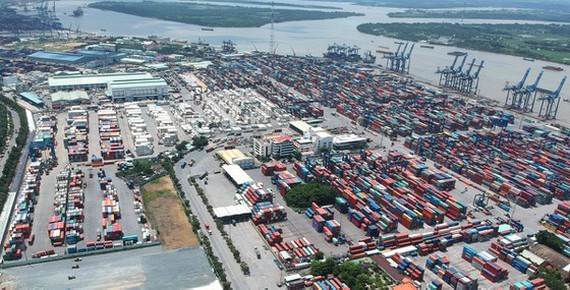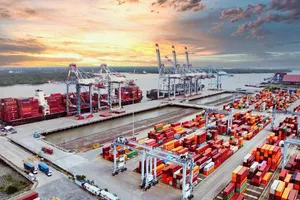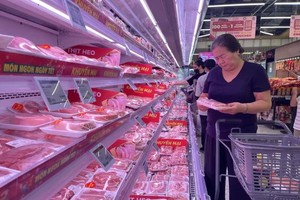
It will also enhance the role of a hub for exchanging domestic goods and connecting the domestic market with the international one, and contribute to the reduction of the proportion of domestic logistics costs in comparison with the national GDP. Specifically, the growth rate of revenue from logistics services of enterprises in the city will reach 15 percent in 2025 and 20 percent in 2030. The proportion of logistics contribution to GRDP of the city will reach 10 percent by 2025 and 12 percent by 2030. The proportion of domestic logistics costs compared to the national GDP will decline by 10-15 percent by 2025.
To accomplish the above targets, the city has proposed groups of solutions to develop logistics infrastructures, such as speeding up the construction of highways that connect the city with provinces and cities in the Southeast; developing a railway network to ensure smooth freight transport, connecting the railway network with important seaports of the city, the Southern provinces and cities, the national railway network, and cross-border shipping routes; investing in the construction, upgrade, and expansion of Tan Son Nhat International Airport following the adjusted plan approved by the Prime Minister with a capacity of 40-50 million passengers per year and 1-2 million tons of cargo per year to 2030.
Along with that, the city will focus on improving and upgrading river channels to ensure the operation of vessels in and out of ports in the region, some main navigational channels, such as the Dong Tranh river channel, to connect freight transport from HCMC to Cai Mep - Thi Vai, and Long Tau river channel through Ganh Rai Bay. It will develop the inland container depot (ICD) system according to the planning to replace and promote the development of multimodal transport and logistics services of the city. At the same time, it will establish a system of logistics centers in seven locations, including Long Binh, Cat Lai, High-Tech Park in District 9, Linh Trung in Thu Duc District, Tan Kien in Binh Chanh District, Hiep Phuoc in Nha Be District, and Cu Chi District with a total area of about 270-623 hectares in the period from 2025 to 2030.
On the other hand, it is essential to promote vocational training in logistics, focusing on vocational skills. The orientation of vocational skills training should follow the demand forecast in the industrial revolution 4.0 to promote vocational training in logistics. It should focus on the vocational training model with the participation of businesses - the dual training form. The city will establish and develop logistics human resource training centers for the whole region, aiming at regional cohesion in training and sharing highly-skilled human resources. The project requires the application of information technology, the development of logistics service users and logistics service providers, regional cooperation and connection for logistics development, and the completion of State management mechanisms and policies on logistics.
According to the assessment of the project, the logistics industry in Vietnam has many advantages and potentials for development in the future. The country has about 4,000 professional enterprises, and the world's leading multinational logistics enterprises have been present in Vietnam. Although the market size is small, at about 2-4 percent, the growth rate is up to 20-25 percent, with abundant human resources. Most of them are the dynamic young generation who can access technology fast. With a favorable geographical location, Vietnam's logistics industry is forecasted to have strong potentials for development, possibly reaching 80-105 TEUs by 2030.
To accomplish the above targets, the city has proposed groups of solutions to develop logistics infrastructures, such as speeding up the construction of highways that connect the city with provinces and cities in the Southeast; developing a railway network to ensure smooth freight transport, connecting the railway network with important seaports of the city, the Southern provinces and cities, the national railway network, and cross-border shipping routes; investing in the construction, upgrade, and expansion of Tan Son Nhat International Airport following the adjusted plan approved by the Prime Minister with a capacity of 40-50 million passengers per year and 1-2 million tons of cargo per year to 2030.
Along with that, the city will focus on improving and upgrading river channels to ensure the operation of vessels in and out of ports in the region, some main navigational channels, such as the Dong Tranh river channel, to connect freight transport from HCMC to Cai Mep - Thi Vai, and Long Tau river channel through Ganh Rai Bay. It will develop the inland container depot (ICD) system according to the planning to replace and promote the development of multimodal transport and logistics services of the city. At the same time, it will establish a system of logistics centers in seven locations, including Long Binh, Cat Lai, High-Tech Park in District 9, Linh Trung in Thu Duc District, Tan Kien in Binh Chanh District, Hiep Phuoc in Nha Be District, and Cu Chi District with a total area of about 270-623 hectares in the period from 2025 to 2030.
On the other hand, it is essential to promote vocational training in logistics, focusing on vocational skills. The orientation of vocational skills training should follow the demand forecast in the industrial revolution 4.0 to promote vocational training in logistics. It should focus on the vocational training model with the participation of businesses - the dual training form. The city will establish and develop logistics human resource training centers for the whole region, aiming at regional cohesion in training and sharing highly-skilled human resources. The project requires the application of information technology, the development of logistics service users and logistics service providers, regional cooperation and connection for logistics development, and the completion of State management mechanisms and policies on logistics.
According to the assessment of the project, the logistics industry in Vietnam has many advantages and potentials for development in the future. The country has about 4,000 professional enterprises, and the world's leading multinational logistics enterprises have been present in Vietnam. Although the market size is small, at about 2-4 percent, the growth rate is up to 20-25 percent, with abundant human resources. Most of them are the dynamic young generation who can access technology fast. With a favorable geographical location, Vietnam's logistics industry is forecasted to have strong potentials for development, possibly reaching 80-105 TEUs by 2030.
























